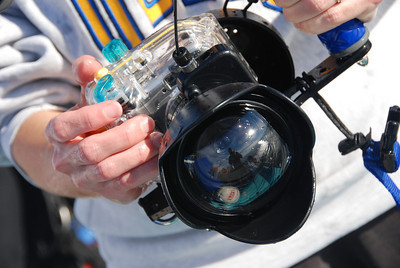Underwater Photography with a compact camera
Key Differences between using a compact and a dSLR
Compact cameras have more depth of field at the same aperture, due to their smaller sensor. This makes it easier to get a larger depth of field, but more difficult to get creative macro shots with a small depth of field and blurred backgrounds.
Compact camera aperture and F-stops
At the widest zooms, the f-stop range of a compact is usually F2.8-F8. On some models, smaller apertures like F11 are allowed when you zoom in further. A few compacts have a widest aperture wider than F2.8, for example the Canon S90 is F2.0 – these are better quality lenses.
Optimal aperture for wide-angle is often F5.6, although it will be better to use F8 if your shutter speed is defaulting to 1/60th to block out more ambient light.
Use F8 for macro for maximum depth of field. If you do not need as much depth of field, you may get sharper images at F5.6 because of more diffraction at F8. I recommend testing your compact camera at home to see if it is sharp at all zoom settings. All compact cameras will need macro mode turned on to focus less than 1 or 2 ft in front of the camera, and also if you attach a dome port to your housing in order to focus on the virtual image.
![]()
Bluewater Photo Guide to the Best Compact Cameras for Underwater in 2019
Focal Lengths of compact cameras
A compact with a 3x zoom, 35-105mm lens is equivalent to a 24-70mm zoom on a Nikon dSLR. A 28-112mm zoom is equivalent to an 18-72mm zoom on a Nikon dSLR. You can read more about focal lengths.
How to use this underwater photography guide
There are many examples in this guide taken with my Nikon dSLR, along with the camera settings. You can “convert” those settings to an ideal compact camera setting by using a wider aperture (smaller F-stop number), a faster shutter speed if it’s a wide angle shot, and shooting at ISO 100.
Shooting extreme wide-angle and macro with a compact
Read the article on wet lenses for underwater photography.
Compact camera underwater photography tips
Because of their smaller sensors, compact cameras have more noise than a dSLR, so you should try to use ISO 100 when possible.
Use of shutter speeds is the same as using a dSLR, with the added advantage that some compacts can sync at very fast speeds, allowing nice sunburst/sunball shots. Maximum sync speeds will vary by model, after a certain speed (e.g. – 1/400th) you may be lowering your strobe power. If you have an external strobe, you should test your camera in manual mode to see how fast you can set the shutter speed and still get maximum strobe power.
Compact cameras can be significantly slower in achieving focus, especially in low light. This, combined with the lack of longer focal lengths, makes fish photography quite difficult. In general, use of an additional light underwater to help a compact camera focus is encouraged.
Most compact cameras can optically trigger one or two strobes via the internal flash, although a few can connect to a strobe via a dedicated sync cord. Because you are usually using larger apertures in a compact camera for equivalent depth of field, stronger strobes are generally not needed with a compact.
Compact cameras do not all have manual mode. If your camera only has aperture priority mode, use that. The shutter speed will usually unfortunately default to 1/60th. When using a strobe in clear or bright water, you may get a lot of ambient light in the photo, even at F8, 1/80th, ISO 100. This will reduce your color and effectiveness of your strobe, since ambient light underwater generally lacks reds.
A few compact cameras can shoot in RAW mode, which is especially useful for ambient light photography. Otherwise, you will be shooting in JPEG mode. Make sure you read the section on manual white balance and other white balance settings.
Compact cameras fog up easier than a dSLR in a larger housing, so using one or two desiccants inside the housing is required.
Further reading
Beginners guide to underwater photography
Best settings for your compact camera underwater
Best settings for macro and wide angle
Beginner’s guide to underwater composition
Preventing backscatter in your underwater photos

RECOMMENDED ARTICLES
SUPPORT THE UNDERWATER PHOTOGRAPHY GUIDE:
The Best Service & Prices on u/w Photo Gear
 Visit Bluewater Photo & Video for all your underwater photography and video gear. Click, or call the team at (310) 633-5052 for expert advice!
Visit Bluewater Photo & Video for all your underwater photography and video gear. Click, or call the team at (310) 633-5052 for expert advice!
The Best Pricing, Service & Expert Advice to Book your Dive Trips
 Bluewater Travel is your full-service scuba travel agency. Let our expert advisers plan and book your next dive vacation. Run by divers, for divers.
Bluewater Travel is your full-service scuba travel agency. Let our expert advisers plan and book your next dive vacation. Run by divers, for divers.































